In the continuing occasional series on crude handmade firearms, we have an entry sent to me by a reader on Facebook (thanks!). It’s a Vietnamese Luger lookalike, which was being sold by Arundel Militaria in the UK (and no, I didn’t buy it – it was already sold when I first saw it).
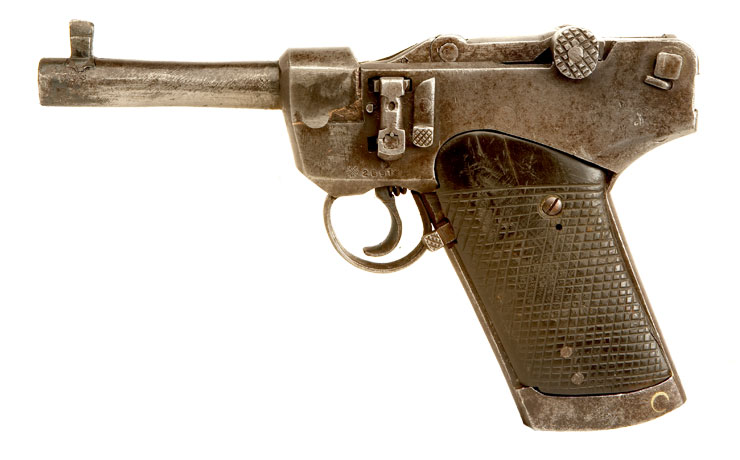
This is quite the crude pistol, but it does appear to actually have a function toggle mechanism – although I suspect it is a simple blowback action that just happens to have a joint in the bolt. There does not appear to be any recoiling section of frame or barrel, and from the look of the magazine it is probably chambered for .32 ACP.
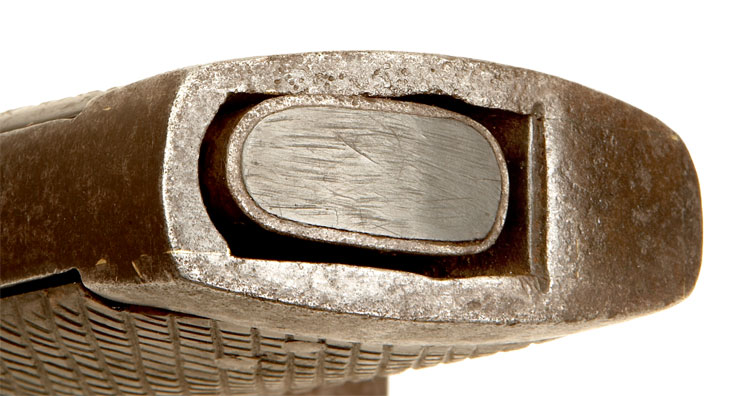
Actual caliber was not specified on Arundel’s listing, not was magazine capacity.
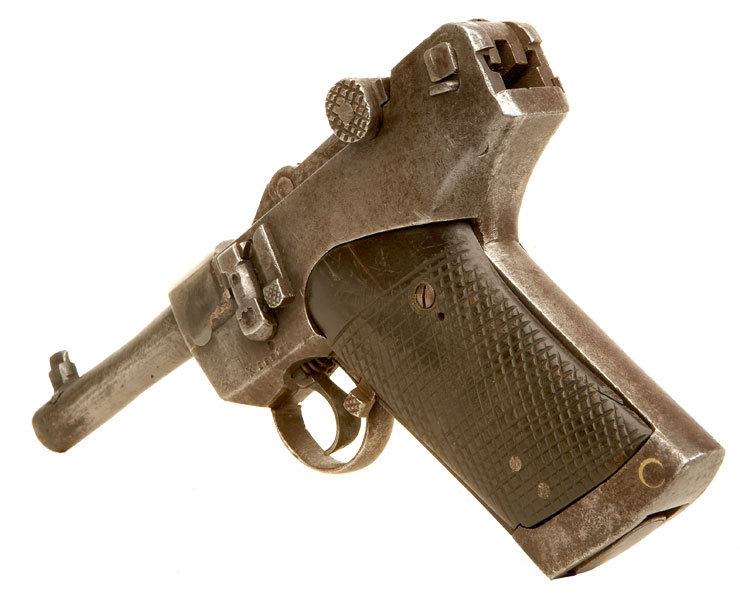
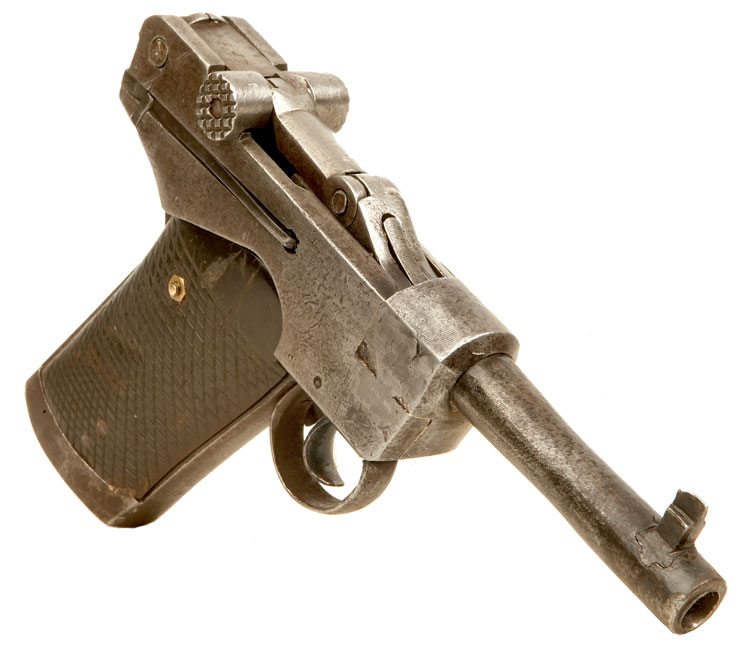

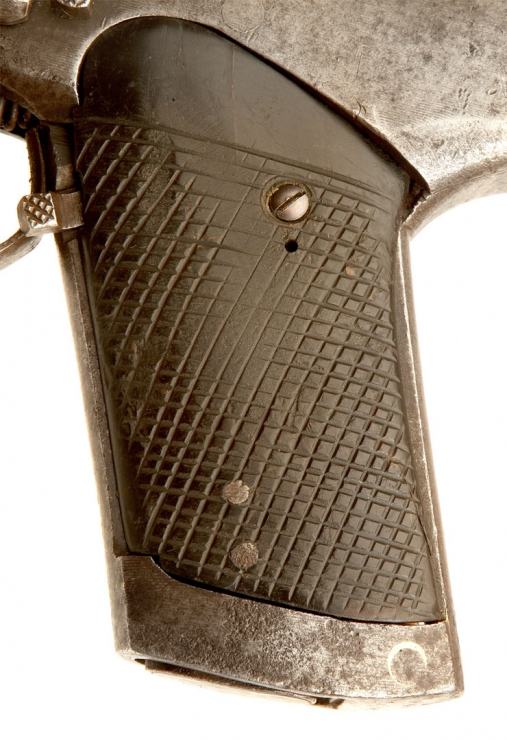
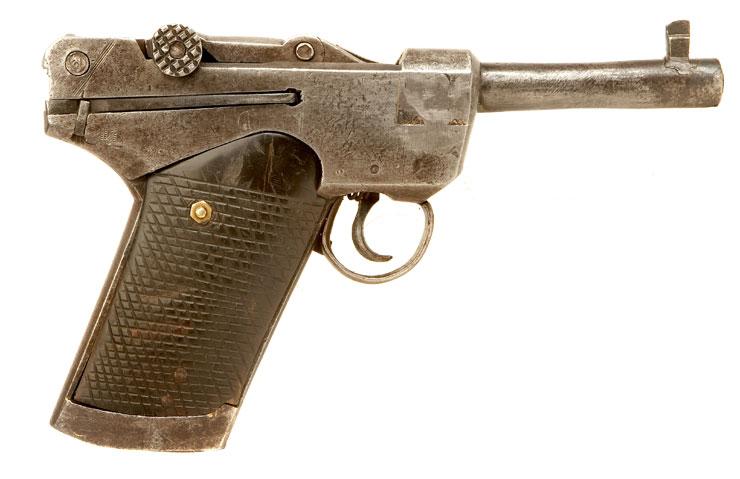

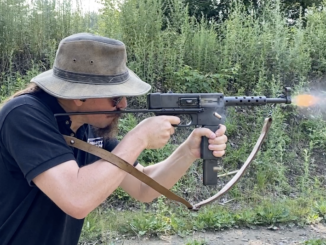

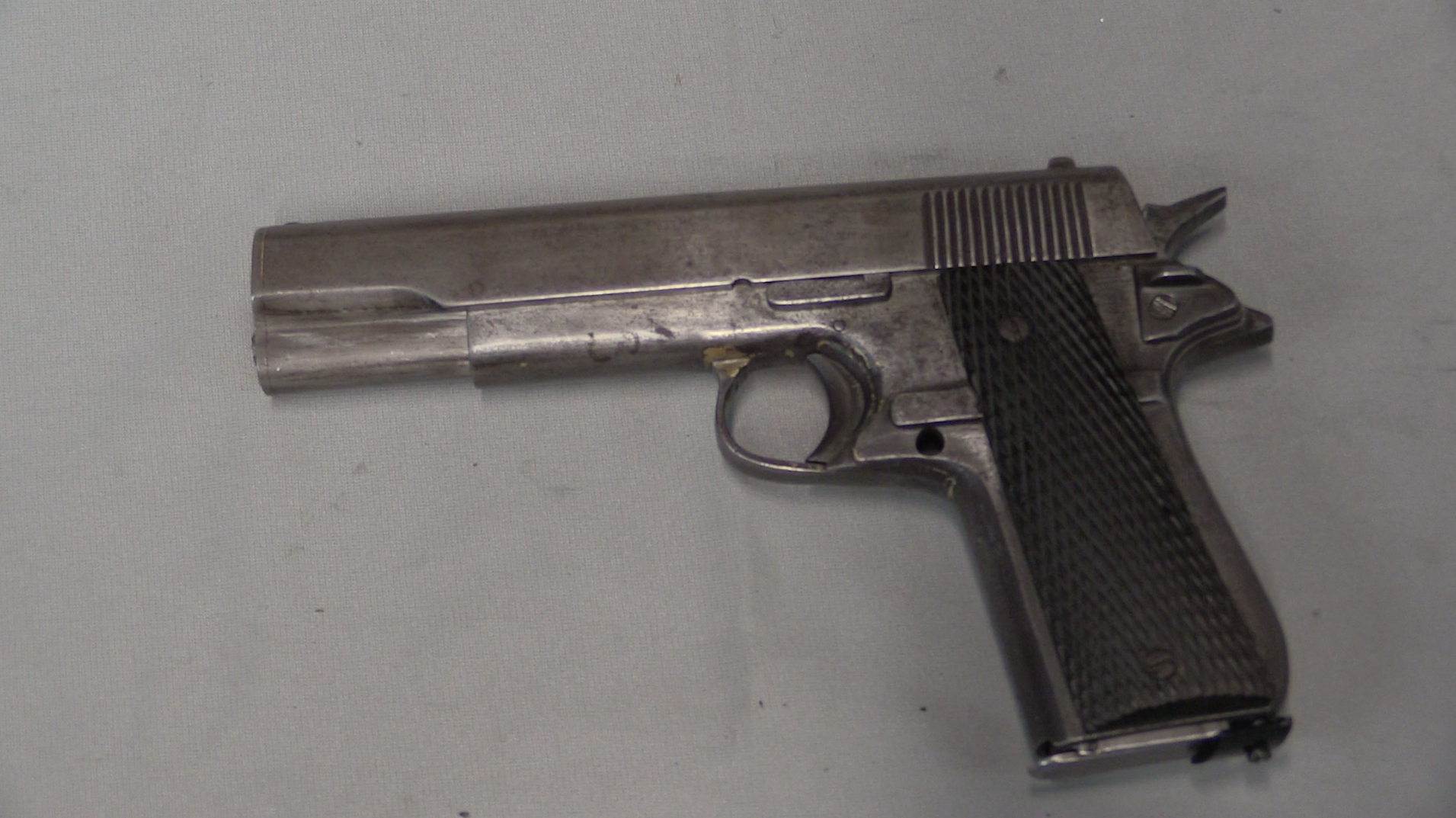
My first thought was where/what did those Bakelite grip scales come from.
It looks like it’s probably buffalo horn.
Thanks for the post, Ian — very interesting artifact. In spite of the obviously crude underground construction techniques the VC had to use in the early days of the Vietnam War, some of these hand-built weapons actually worked reasonably well ( depending on which gunsmith did the work ). I seem to recall reading from time to time about similar copies from that era of the M1911A1 pistol.
Interesting to see how much extra work was done just to copy a Luger.
Does it have rifled or smooth-bore?
Trigger guard looks as too small me, but maybe in reality it is not(?)
Front sights looks peculiar.
Notice the gold-plated hex bolt in right grip panel.
What is that hole at back of weapon in weapon at photo “Rear quartering”, it have some purpose or not?
Wow. That’s a mighty ambitious project, given how crudely it turned out.
There are markings that appear to be a serial number. I wonder if that was an attempt at irony?
The marking on the toggle may be intended to be a serial number, but I think (and some UK reader may either elaborate or correct me) that the “serial number” on the left side of the frame above the trigger is a deactivation reference.
It’s the UK, not just anybody can geld a gun over there.
Looking at the angle on that toggle, definitely straight blowback.
George Chinn http://www.ibiblio.org/hyperwar/USN/ref/MG/IV/MG-V4.pdf might disagree. (84Mb of dense technical material) Beginning on p54 he discusses retarded blowbacks and toggles. Missing from his analysis is any mention of lateral deflection which he assumes to be trivial, but on this gun is not. The center pivot looks like it had spread (no doubt enhanced by the machining overcut) and been squeezed back together.
Test firing this gun with a string probably revealed poor feeding and rapid self destruction. It may be manually operated with a cross bolt just to the rear of the chamber.
I have an old copy of “Small Arms of the World” 1969 edition, and they show copies of the M1911A1 and the Browning Hi-Power made by the Cao Dai which was or is a South Vietnamese group.
The Cao Dai P-35 copies could generally be ID’d quickly. Their slides were straight-sided, lacking the forward scallop on each side of most FN copies, and they had a 1911-type separate barrel busing rather like a Tokarev, probably because it was easier to make the slide open at the front than to drill a blind hole for the recoil spring tunnel.
cheers
eon
was an advisor to the vietnamese 36th ranger battalion, 1966-67. we picked up a 45 caliber model 1911 look a like, (barely) and it had no magazine, just load from the top. the rangers threw it into a river. should have photographed it.
@ TomTB & Charlie :
Thanks very much!
Nice.
Proof that determined people will always be armed. I have seen dozens of Chinese and Indochina handguns, ambitious copies of C96, Brownings and things directly from the imagination of the makers,but never a Luger.
The thing that impressed me the most as being the most time-consuming and ultimately unnecessary action was the machining of the frame just above the grip panel. The graceful arch looks pretty enough, but my God, how much extra machining/casting/filing was needed just to look esthetic???
Not even the Luger or the Nambu have that graceful component!
It makes me wonder if the frame wasn’t repurposed from something else.
Note that there seem to be some welds or solder joints in the frame too (for example, from the bottom in front of the magwell, where the sides of the grip join the front grip strap).
It’s a bizarre mélange of crude and fine work, with the balance point definitely towards “crude.”
my thought is that the purpose was to make it look as much like a manufactured gun as possible. Look at the Chinese mystery pistols where a grab bag of markings are put on them to mimic factory gun markings. At a distance something like this could pass for a “real” gun unless it is so obviously crude.
That front sight dovetail looks like it might cut through into the bore.
Given easier firearms to copy I suspect the guy who made this just wanted to give a Luger a go. Probably done with the most basic of tools one has to admire the genius, adaptability and inventiveness of the human spirit
Trigger lever exposed on the side of the gun … could be an issue … ^__^
Yes, but the exposed sear wouldn’t be an issue had there been a safety catch. The awful Type 94 pistols had exposed trigger sears, but the safety catch would most certainly prevent accidental discharge when in safe mode.
I think that the awfulness of the Type 94 has been exaggerated by popular account, largely based on the terrible quality of the late war crude production examples. The pistol did have a serious design flaw, but in practice it does not seem to have caused many accidents, because accidentally depressing the exposed sear with sufficient force was quite unlikely. Otherwise it was adequate for a compact self-defense pistol, even if the capacity was a little low.
You can actually fire a Luger by depressing a sear. Not easy to do but possible, I did it (purposefully, on empty gun).
True … see “Police sear safety” ^__^
https://www.ar15.com/forums/t_5_44/162446_Police_Luger_with_police_sear_safety.html
Scroll down to the bottom for pictures.
In any case, the Nambu is still much better than the Glisenti in that it will not blow itself up when you pull the trigger.
A Glisenti is safe if used with 9mm Glisenti ammunition. Unfortunately, this ammunition has the same dimensions as 9mm Parabellum, and that is not safe to use in a Glisenti. It’s similar to the danger of using .38 Super in a .38 ACP pistol.
It is notable that the Beretta M1923, which also fired the 9mm Glisenti, was a straight blowback pistol. Still, the 9mm Glisenti was probably one of the hottest cartridges (124 grains @ 1000 fps for 275 ft·lbf of muzzle energy) which could be safely fired from a straight blowback pistol without making the slide very heavy.
I don’t know if any Italian officers ever tried to fire 9mm Parabellum SMG ammunition with their Beretta M1923. The Italian SMG ammunition was very hot, +P+ by modern terminology. The results with an M1923 would have probably been interesting…
Well, it does appear to have a safety catch. That’s the little lever with the knurled end behind the trigger lever. It looks like the curved end at the top would swing down and lock the sear into engagement with the striker. All well and good, but if it isn’t engaged when you pull the pistol and the top of that lever gets snagged on something, that’s what’s called a recipe for disaster. There is a certain amount of expectation that the trigger is the only part on the outside of a gun that will cause it to fire, and “trigger discipline” isn’t worth much if there are other options. ^__^
These firearms are fascinating, thanks!
Years ago I handled a nearly new type 94 and tried pressing the sear bar myself to see if the story was true. Yes, it could be fired that way but it required a lot of thumb pressure to do it, almost all I had.
The Erma KGP series pistols in the 1960s and ’70s used a variant of the Maxim/Borchardt/Luger toggle system in a retarded-blowback mode. By varying the position and height above bore CL of the toggle, they could be engineered for any caliber from .22LR to 9 x 19mm. Most were .32 or .380 ACP. They can be distinguished from a “true” Parabellum by the lack of the boxy sear housing on the left side.
Note the angled block bar aft. It stakes the external ejector spring bar in place, rather like the vertical retaining pin in the actual Parabellum design.
The safety seems patterned more after the Nambu Type 14 than the P.08. It apparently acts on the sear at the front, probably locking it and/or the trigger. It’s less secure than the Nambu, though, because the latter worked on a 180-degree arc (forward-fire, back- safe). This one works on an arc of 90 degrees or less. Even with wear, the Nambu was far less likely to go to “bang” mode without the shooter’s deliberate effort.
The magazine catch is a puzzler. It looks like it should work like the one on a modern Walther or H&K, but the knurling indicates it needs to be pushed inward, rather than down as its lever-like arm seems to imply.
Also note the rear toggle pivot pin. The bar next to its square head on the left side seems to be there to prevent it from rotating. But there really isn’t much to keep it from simply falling out.
cheers
eon
I have seen DIY copies of firearms from around the world made with the simplest tools under the most primitive conditions; even from countries where just having a gun of any type would get you killed on the spot by the authorities. Yet, I always fail when I try to point out this main weakness to the Anti-Gunner’s Utopian Dream. Guns are simply TOO EASY to build. And with our American penchant for home shops being well stocked with a lot of high quality tools, there is Just NO WAY that anyone can effectively disarm Americans unless they murder upwards of 100 million of those who want them.
By the way, my favorite weapon made by the Viet Cong was that French Submachinegun—the MAS-49 I believe it was designated. Simple, rugged, reliable and very effective in a world without body armor
While it is true that a functioning firearm can be made from scrap in pretty much any country, there is the question of how effective these home-made models would be, or how easy it is to actually build a good homemade gun.
The fact is that the vast majority of improvised firearms tend to be made by guerrilla fighters during civil wars, or organized criminal outfits in countries with high crime rates. Improvised guns are rarely ever made by petty criminals, and almost never by otherwise law-abiding citizens. Most examples come from Central and South American cartels, Eastern European militias and terrorist groups, and historically from occupied countries like Vietnam, Kenya and Afghanistan.
I agree that “disarming” the American populace would be an unrealistic task, but I am not entirely convinced that improvised weapons would start popping up around the country if it were to ever happen. I also don’t think that the anti-gun lobby is particularly worried about the apparent threat that improvised guns pose; most poorly-made improvised guns pose more threat to the user than anyone else, and even the best-made examples are not going to be as effective as a factory-made rifle or handgun.
Just my two cents on the issue. I find improvised firearms fascinating, but their effectiveness is definitely exaggerated. Wars cannot be won with improvised weapons alone.
Really? Perhaps you should ask one of the thousands of people killed with improvised weapons each day around the world. Improvised weapons give you the opening to kill the enemy and take his weapons, equipment and ammunition. They are not meant to be the only weapons you have, just a stepping stone.
First off, I highly doubt thousands are killed daily at the hands of people armed with improvised workshop firearms. As far as I know, there is no reliable way of measuring this.
Secondly, the idea of using improvised, single-use weapons in order to obtain military-grade arms is idealistic, but unrealistic. If we’re talking about guerrilla fighters here, then the enemy forces in question are likely an occupying army or government force. These forces largely congregate in organized squads, and rarely would a guerrilla have the opportunity to eliminate a single soldier and steal their weapon unnoticed. This was the logic behind the “Liberator” pistol manufactured en masse during WW2 and airdropped to European resistance forces – however, there are few recorded cases of the Liberator actually fulfilling its intended role, and it made negligible impact on the efforts of the resistance.
Enemy arms and munitions are usually obtained through having proper arms and munitions of your own. Guerrilla armies don’t come to existence purely through stealing government equipment with improvised arms; they receive foreign weapons and aid, or smuggle arms across borders, in order to eliminate their enemies and steal their equipment. The Viet Cong relied mainly on donated Soviet and leftover French equipment, just as the militias of Afghanistan relied mainly on donated U.S. and leftover Soviet equipment.
Besides, almost every militia or terrorist group in the 20th and 21st century thus far has mainly relied on improvised explosive devices, rather than firearms, in order to ambush enemy forces and steal their gear.
I think the point is that any belief that gun prohibition will disarm criminals is deluded. Even if all legal guns were rounded up in the USA, or subject to Australian or UK type gun control, which is frankly hard to imagine, within a short time high quality firearms would start to be produced from numerous underworld facilities. The equioment needed to make simple guns is readily available, and remember these Vietnamese guys made their “Luger” with hand tools.
As experience from Britain and Australia shows, the only people disarmed by gun bans are the law abiding, and you have to conclude that that is what the purpose of the policy really is. Gun banning politicians are not really concerned about criminals being armed, they do not want the majority of law abiding people to have access to arms.
Gun control is about population control.
You can believe what you want, reality is people are routinely killed with improvised weapons on a daily basis all around the world. Africa, South America(which has a huge home built weapons problem, especially Brazil) and Asia are riddled with do it yourself gunsmiths. Pakistan and Afghanistan are major sources of handmade as well as factory made weapons, and their backyard gunsmiths turn out excellent work.
While you are correct that many of the DIY weapons are, to put it mildly, crude in workmanship and materials; there are many examples that are very sophisticated. As an example, the Gunsmiths of Afghanistan made such a good copy of the Lee-Enfield prior to WWII, that the British Army purchased over a million copies for use by insurgents and colonial forces fighting the Japanese. The same can be said about the Chinese copies of the Model 98 Mauser made in China, though there were many instances where the local manufacturers used very substandard materials. Even Today, you can purchase hand made AK-47 and AK-74 copies made by the Afghan gunsmiths for the local trade; some with rifling and others without, but all fully functional. There was even a case a few years back when Chicago had one of those “Gun Buybacks” where an enterprising young man got a bunch of his friends together and had them make a whole lot of “Zip Guns” which he “sold” to the Authorities. Rumor has it, that he paid for his college education from the proceeds.
Regardless, given that American hobbyists have access to extremely good metal working tools, including CNC and 3D printers, and high grade materials, it would not take very long for thousands of home shops to begin cranking out high quality weapons as well as the tooling to manufacture ammunition, should a ban on that occur. This doesn’t even count what Organized crime would be able to produce with its much larger budgets. If I recall right, The original Black Panthers produced a workmanship copy of a SMG during its Vietnam Era hay day.
I personally dread the thought that someone like Hitlery could succeed in imposing a “Australia Style Gun Confiscation Program” in the United States, as I have studied what happens in Nations where over 10% of the population actively fights such laws. The death toll in the United States would be worse than anything ever seen to date.
Shame that America is more like the Pakistani frontier or narco-country than it is like its fellow English-speaking White countries Australia or Canada, which its armed racist demagogues claim all share superiority over all other nations. Which will soon become apparent in their response to the pandemic compared to Australia and Canada.
And you right-wingers had no problem with Governor Ronald Reagan using gun control laws tailored to attack the Black Panthers. But it’s never terrorism when a White patriot does it.
While it’s nice to something like that I own a Luger and there is no way I’d fire that.
Keith:
You couldn’t fire it even if you wanted to. As it is for sale in the UK, it has been “deactivated”. The more interesting question is: how did it end up in Britain at all? I’d love to know the answer to that.
Funny, I was wondering the same exact thing!!
I live in the UK, and was also the one who sent Ian this link. Its not as hard as you would think to get deactivated weapons here, registered firearms dealers can get brand new live firearms shipped into the UK with the correct import license, from there they just pay about £200 or so to have it deactivated and certified for sale to anyone. There is a huge market especially for WW1 and WW2 deacts here, but its pretty common to see a brand new out of the box Glock or Sig for sale too, so this was most likely simply purchased from someone over the pond in the states!
Offa:
That is the case at present, but the EU wants to pretty well end the sale and ownership of deactivated arms.
Are you sure that’s not a Taurus?
Firing from guns like this I won’t even take a chance,
Is anyone see how barrel twisted is???
Less likely bullet can fly out of this barrel,unless this was an deactivation process……
This piece of junk can’t even be compared to Luger,that self made knock off was build very crudely and have very poor finishing on it….
By purchasing something at 800-1000 bucks you can buy an high tech pistol rather than that..
That isn’t the point. I could probably buy 50 Glock 19s for the price of a mint Borchardt, but at this stage of my life I would prefer the Borchardt. I have plenty of modern “shooters,” but I would pay a premium for the history and rarity. It might be junk on the range, but it is historically significant junk that would fit nicely into a collection of Vietnam and Cold War era firearms. Besides, it only had to work once to serve its intended purpose.
Having seen a few of these Vietnamese handmade guns, it seems the designers assumed that having their gun resemble a better, well-known gun would automatically make it as good as the gun they were copying.
i have “small arms of the world”(1957edition) great book eh?i havnt seen a modern book that matches it for quality of illustrations,apart from the “janes military” books.
some of the “small arms”drawings apear to be life size,i have measured various parts/bullet dimensions etc the 1969 edition sounds interesting i wonder if any of the series is available on pdf?
back to the “jungle workshop”copies the thompson smg copy looks very well made and so do the 1911 copies i wonder if anyone could get permision to test fire one?
all the best
john
nottingham
uk